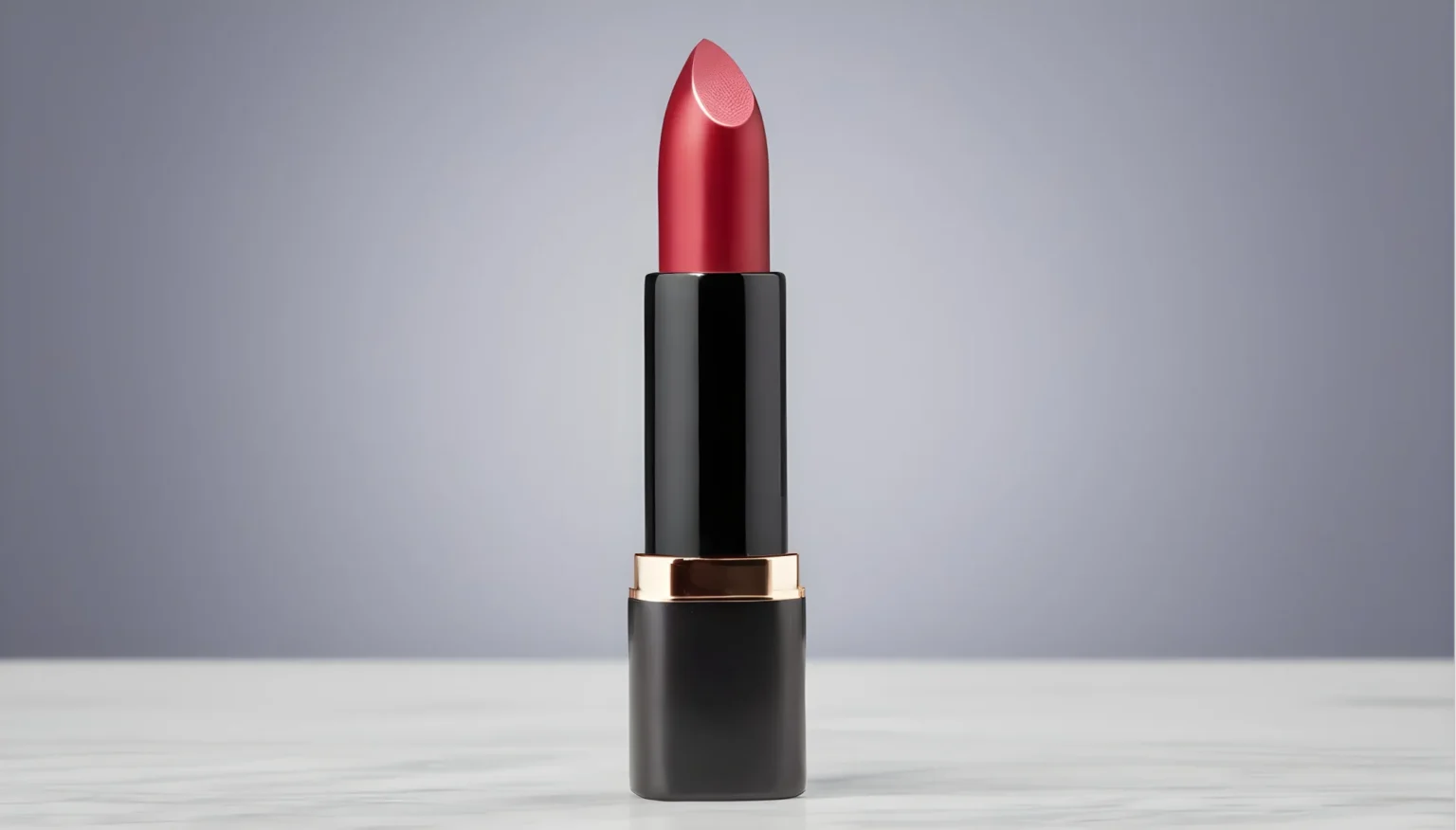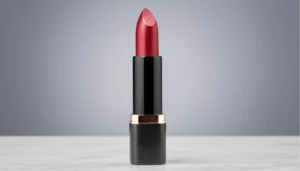Lipstick photography plays a crucial role in the beauty industry by showcasing colors, textures and the overall appeal of your product. Visually appealing images are important to attract customers as they influence the purchase decision.
High-quality product photography can effectively showcase the unique features of a lipstick, create desire for the product and increase brand visibility and recognition. Remember, a picture is worth a thousand words, and in the beauty industry, a captivating image can be the catalyst that turns potential customers into loyal ones.
Types of lipstick

Each type of lipstick has unique characteristics and benefits, therefore, it is essential to choose the type that works best for your preferences and needs. Whether you prefer a matte, glossy, satin, or sheer finish, there is a type for everyone. However, to help you better understand your customers, here are the most used ones.
Liquid Matte. This type offers a long-lasting, opaque finish that dries down to a matte, velvety texture on the lips. This is popular for its highly pigmented colors and staying power, making it a favorite choice for those looking for a bold and transfer-proof lip look.
Liquid Glossy. Liquid glossy lipsticks provide a shiny, high-shine finish on the lips, giving them a lustrous and radiant appearance. They often have a soft, non-sticky texture and offer a glossy, wet look to the lips, perfect for those who prefer a more luminous finish.
Classic Matte. The classic matte comes in traditional bullet form and offers a matte finish with a smooth texture on the lips. These are known for their intense color payoff and long-wearing formula, providing a velvety, non-shiny look on the lips without any shimmer or gloss.
Classic Glossy. Similar to the liquid glossy, it provides a shiny, reflective finish on the lips, giving them a glossy and plump appearance. They often come in bullet form and offer a hydrating and comfortable feel on the lips, perfect for those who prefer a more traditional glossy finish.
Lip Balm. Lip balms are a hydrating and moisturizing lip product that helps to nourish and protect the lips from dryness and chapping. They typically come in a balm or salve form and offer a sheer, natural-looking tint to enhance the lips’ appearance while providing essential hydration. Lip balms are perfect for everyday wear and are available in a variety of formulas, including tinted options for a hint of color.
There are several types of lipstick on the market, but to properly advertise them and reach your target audience, you should be aware of the nuances each type has.
Close-up glamor shots
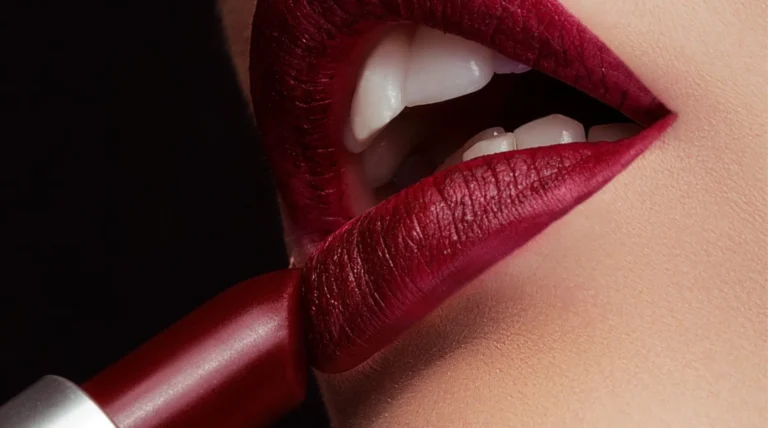
Close-up glamor shots are highly important in showcasing texture, color, and packaging as these elements allow customers to see the product in great detail.
This type of shots highlight the richness of the color pigment as well as the smoothness of the texture. Combine these with the intricacies of the packaging, and you obtain an image that describes all the important factors in a customer’s decision-making process.
To capture intricate details effectively consider the following tips:
- Use a macro lens, as it allows you to get up close to the product and capture fine details with clarity and precision.
- Proper lighting is essential for capturing details. Use soft, diffused lighting to avoid harsh shadows and ensure that the colors are represented accurately.
- Focus on the focal point. Identify the key details you want to showcase (such as the texture of the lipstick or the branding on the packaging) and ensure that they are sharp and in focus. Keep in mind that only one element can be the “star”, otherwise, if you add more, they might confuse the audience.
- Use a tripod. For close-up shots, even the slightest movement can cause blurriness. Using a tripod can help stabilize your camera and ensure sharp images.
- Experiment with angles. Try shooting the item from different angles to highlight different aspects of the product, such as the packaging design, the color payoff, or the texture.
By paying attention to these details and techniques, you can capture stunning close-up glamor shots that effectively showcase the beauty and uniqueness of the product.
Creative flat lays
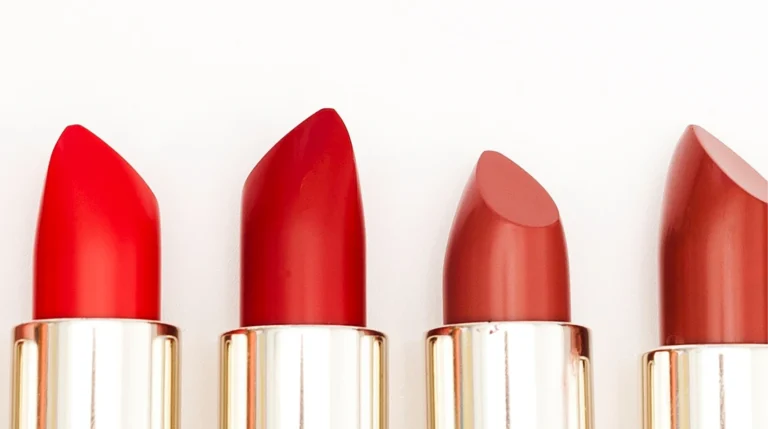
Flat lay photography is a popular and versatile style of photography where items are arranged on a flat surface and photographed from above. In the context of lipsticks, it can be used to create visually appealing and aesthetic images that showcase the product in a creative and engaging way.
When creating flat lays, consider the following ideas for incorporating complementary accessories to enhance the overall look:
- Use props that enhance the theme. Select props and accessories that complement the color, texture, or theme of the item. For example, you could use flowers, fabric, or small decorative items that match its shade or packaging design.
- Play with textures and patterns. Mix and match different textures and patterns to add visual interest to your flat lay. Consider using a textured background or incorporating patterned items like scarves or papers to create depth and dimension.
- Include beauty tools or products. Incorporate beauty tools such as brushes, mirrors, or makeup palettes to add context and create a cohesive beauty theme in your flat lay.
- Experiment with composition. Play around with different compositions and arrangements to create a visually appealing layout. Consider symmetry, balance, and spacing to create a harmonious and eye-catching flat lay.
- Utilize natural light. Lighting is crucial in flat lay photography. Place your setup near a window or in a well-lit area to ensure that the colors and details are showcased effectively.
By incorporating these ideas and tips into your flat-lay photography, you can create visually engaging and aesthetically pleasing images that attract attention and showcase the beauty of the product in a creative and captivating way.
Ombre blends
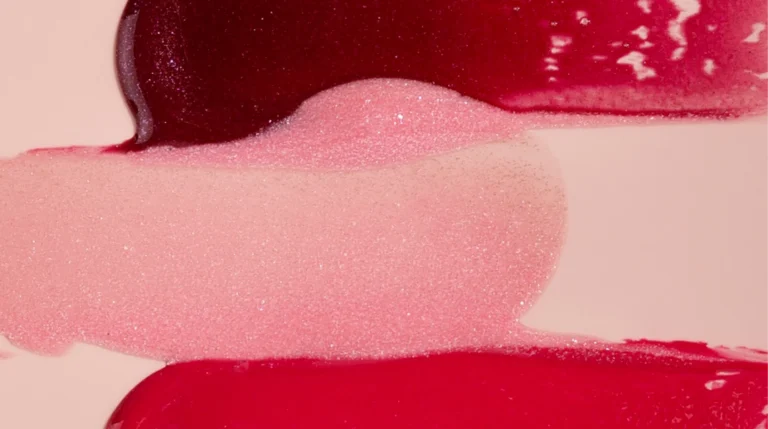
Ombre lipstick blends have become a popular trend in makeup artistry, offering a unique and stylish way to wear multiple shades in a single look. The ombre effect involves blending two or more lipstick shades to create a seamless gradient from one color to another. This technique can add dimension, depth, and visual interest to the lips, resulting in a captivating and standout makeup look.
Here are some techniques for blending different shades to create a captivating ombre effect:
- Choose complementary shades. Select two or more shades that complement each other and create a harmonious blend. Consider using shades that are in the same color family or that create a pleasing contrast when combined.
- Apply the lightest shade first. Start by applying the lightest shade to the center of the lips. This will serve as the base color for the ombre blend.
- Layer the darker shade. Using a lip brush or your fingertip, apply the darker shade to the outer edges of the lips. Gently blend the darker shade into the lighter shade, creating a smooth transition between the two colors.
- Blend the colors. Using a lip brush or a clean fingertip, gently blend the two shades, focusing on the areas where they meet. Use light, feathery motions to create a seamless gradient between the colors.
- Add dimension. To enhance the ombre effect, you can further blend the colors by patting the lips together or using a lip brush to smudge the colors together. This will create a more blended and diffused look.
- Finish with a lip liner. To define and refine the ombre blend, you can use a lip liner to outline the lips and create a crisp edge. Choose a lip liner that matches the darkest shade for a seamless finish.
Experiment with different shades and blending methods. Then, edit each picture with post-production techniques until you have the desired image. By doing so, you can intelligently showcase your items while providing informative content for your customers.
Product in action
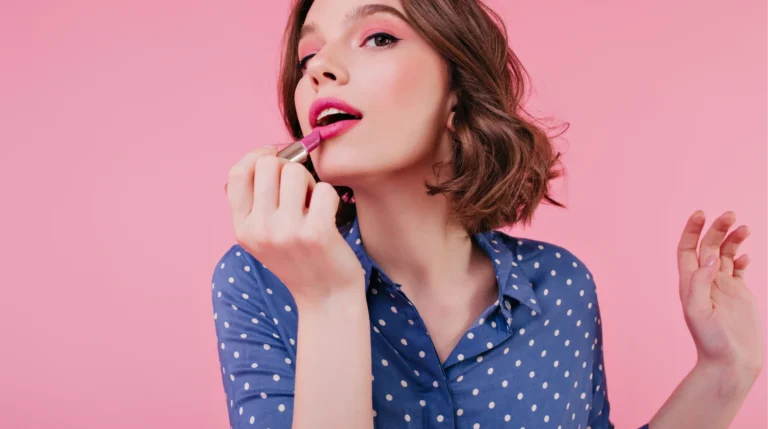
Showcasing lipsticks being applied in real-life situations can have a significant impact on potential customers as it allows them to see how the product looks and performs in a practical setting.
By capturing candid shots of models using it, you can provide a more realistic and relatable representation of the product, helping customers make informed purchasing decisions and visualize how it will look on themselves.
Here are some tips on capturing candid shots:
Choose the right setting. Select a setting that complements the shade and enhances the overall mood and aesthetic of the image. Consider using natural lighting or a well-lit area to highlight the lipstick and ensure that the colors are true to life.
Focus on the application process. Capture close-up shots of the model applying the lipstick, focusing on details such as the precision of the application, the texture, and the color payoff. This will give viewers a better idea of how it looks and feels on the lips.
Encourage natural and spontaneous movements. Instead of posing for the camera, encourage the model to apply the product naturally and expressively. This will create a sense of authenticity and realism in the photos, making the product appear more relatable and appealing to viewers.
Capture different angles and perspectives. Experiment with different angles and perspectives to showcase the item from various viewpoints. Consider taking shots from above, from the side, and up close to capture the details of the application process and highlight the features of the lipstick.
Emphasize facial expressions and emotions. Capture candid shots of the model’s facial expressions and emotions as they apply it. This will convey a sense of joy, confidence, and satisfaction, helping viewers connect with the product on an emotional level.
Edit minimally. Keep the editing minimal to maintain the natural and candid look of the photos. Enhance the colors, brightness, and sharpness as needed, but avoid over-editing to preserve the authenticity of the images.
These lipstick product photography ideas will help you create impactful images that resonate with your audience.
High-contrast black and white
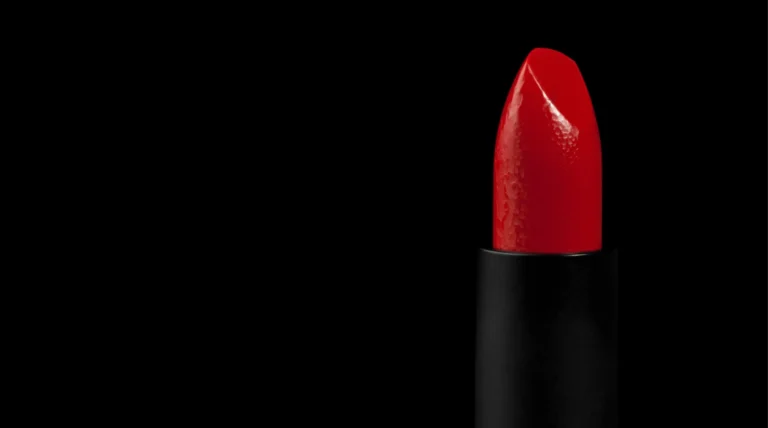
Black and white photography has a classic and timeless appeal that exudes sophistication, elegance, and drama. By stripping away color and focusing on the interplay of light and shadow, black-and-white images can elevate the visual impact of lipstick photography, highlighting the texture, details, and nuances.
Here are some reasons why black-and-white photography is so popular and effective:
Timeless aesthetic. Black and white imagery has a long history in photography and art, evoking a sense of nostalgia and timelessness. By capturing it in black and white, you can create a vintage-inspired look that transcends trends and fads, making the images feel classic and enduring.
Focus on texture and details. Removing color from the equation allows the viewer to focus on the texture, details, and subtle nuances, such as the glossy finish, matte texture, or shimmering pigments. Black and white photography can accentuate these features, creating a visually compelling and tactile image.
Emphasis on contrast and tonality. Black and white images rely on the interplay of light and shadow to create contrast and depth. By manipulating the exposure, lighting, and composition, you can achieve a high-contrast effect that adds drama and impact to the photography, making it visually striking and memorable.
To achieve high-contrast and visually striking image, consider the following:
Use directional lighting. Experiment with different lighting sources, such as natural light, studio lights, or a combination of both, to create directional lighting that enhances the highlights and shadows. Play with the placement of the light source to sculpt the shape of the product and create dynamic shadows.
Experiment with shadows. Shadows can add depth and dimension to black-and-white images, emphasizing the shape and form. Play with the placement of the item and the light source to create interesting shadow patterns that complement the composition and add visual interest.
Adjust the contrast. Use editing software or post-processing techniques to adjust the contrast and tonality of the black and white images. Enhance the highlights and shadows to create a dramatic effect, drawing attention to the details and texture.
Focus on composition. Pay attention to the composition of the image, including the placement of the product, the angle of the shot, and the framing of the subject. Experiment with different angles, perspectives, and compositions to create visually dynamic and aesthetically pleasing images.
Therefore, you can achieve high-contrast and visually striking black-and-white lipstick photography that showcases the timeless appeal and elegance of the product in a captivating and memorable way.
Reflections and mirrors
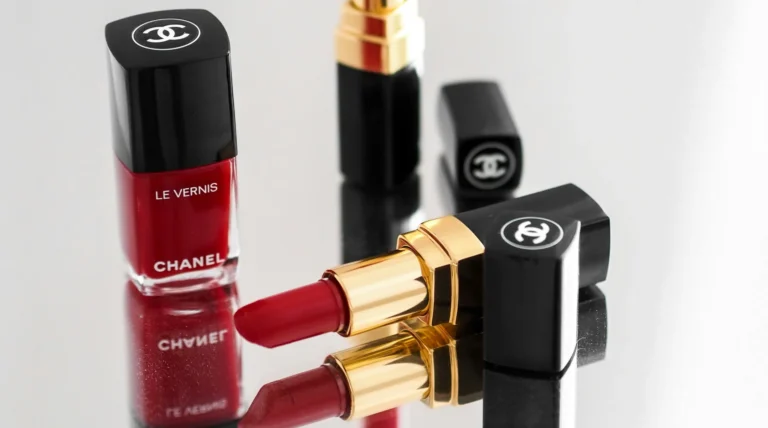
Using mirrors and reflective surfaces in photography can add a unique and dynamic element to the images, creating visually intriguing compositions and adding depth and dimension to the photographs.
Reflections can enhance the overall aesthetic of the photos, highlighting the lipstick from different angles and perspectives and creating interesting visual effects that capture the viewer’s attention.
Here are some reasons why mirrors and reflective surfaces are effective in photography:
- Showcase different perspectives: Mirrors and reflective surfaces allow you to capture the item from multiple viewpoints, showcasing different angles, details, and features of the product. By incorporating reflections into the composition, you can create a sense of depth and dimension, making the images more engaging and visually appealing.
- Add visual interest: Reflections can add a layer of visual interest to photography, creating dynamic and interactive compositions that draw the viewer’s eye. The interplay of light, shadow, and reflection can create striking and captivating images that stand out and leave a lasting impression.
- Enhance the storytelling: Mirrors and reflective surfaces can help tell a story or convey a message. By reflecting specific elements, objects, or settings in the mirror, you can create a narrative or mood that adds depth and context to the images, making them more compelling and evocative.
Here are some tips on capturing interesting reflections to add depth:
Experiment with different angles. Position the item and the reflective surface at various angles to capture different reflections and perspectives. Play with the placement of the mirror to create interesting compositions and visual effects that highlight it creatively and engagingly.
Control the lighting. Adjust the lighting to control the intensity and direction of the reflections. Experiment with natural light, artificial light, or diffused light to create soft, ethereal reflections or dramatic, high-contrast effects that enhance the overall aesthetic of the images.
Frame the composition. Pay attention to the composition of the image, including the placement of the lipstick, the mirror, and other elements in the frame. Consider incorporating leading lines, patterns, or symmetry to guide the viewer’s eye and create a harmonious and visually appealing composition.
Play with depth of field. Experiment with depth of field to create a sense of depth and focus in the images. Use a shallow depth of field to selectively blur the background or foreground, emphasizing the reflections and drawing attention to it as the focal point of the composition.
By using mirrors and reflective surfaces in lipstick photography and following these tips, you can create visually captivating images that creatively highlight the beauty of the product.
Seasonal themes
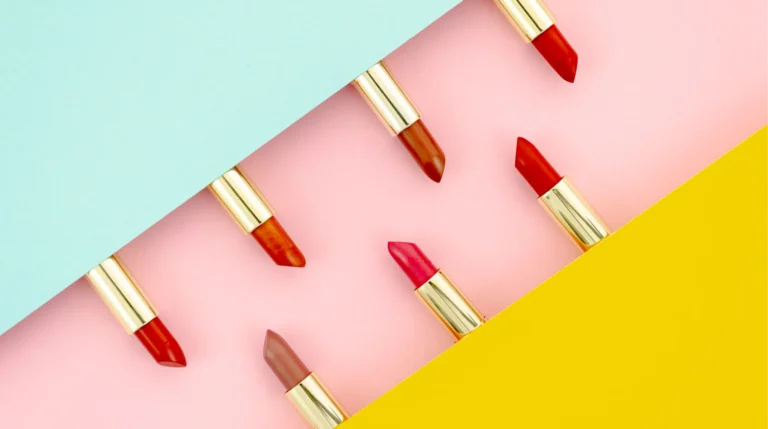
Aligning lipstick with different seasons or holidays can help create a connection with your audience, capitalize on seasonal trends and themes, and add a festive and timely touch to your images. By incorporating seasonal elements, colors, and aesthetics into your photography, you can make your products more relevant and appealing to consumers who are looking for products that resonate with the current season or holiday.
Here are some reasons why aligning your product photography with different seasons or holidays is important:
- Relevance and engagement. By incorporating seasonal themes and colors into your advertising photography, you can make your images more relevant and engaging to your audience. Consumers are often looking for products that reflect the current season or holiday, so aligning your photography with these themes can help capture their attention and interest.
- Capitalize on trends: Seasonal trends and themes are a great opportunity to showcase your products in a timely and on-trend manner. By adapting your marketing photography to align with popular seasonal colors, motifs, and aesthetics, you can leverage the excitement and buzz surrounding these trends to attract new customers and drive sales.
- Create a cohesive brand image: Aligning your photography with different seasons or holidays can help create a cohesive brand image that resonates with your target audience. By consistently incorporating seasonal elements into your images, you can establish a strong visual identity that reflects your brand values and aesthetic, while staying relevant and engaging to your customers.
Here are some examples and ideas for adapting your lipstick photography to seasonal themes:
Spring. Embrace pastel colors, floral patterns, and soft, airy lighting to capture the freshness and renewal of spring. Incorporate blooming flowers, greenery, and natural textures to create a light and airy vibe that complements the season.
Summer. Opt for bright and bold colors, vibrant patterns, and tropical motifs to capture the energy and warmth of summer. Experiment with playful compositions, colorful backdrops, and outdoor settings to evoke a sense of fun and relaxation.
Fall. Embrace warm and cozy colors, rich textures, and earthy tones to reflect the changing leaves and cooler temperatures of fall. Incorporate seasonal elements like pumpkins, leaves, and flannel patterns to create a cozy and inviting atmosphere that resonates with the season.
Winter. Embrace cool and icy tones, shimmering textures, and festive motifs to capture the magic and sparkle of winter. Incorporate holiday decorations, snowflakes, and cozy sweaters to create a sense of warmth and holiday cheer in your images.
To enhance your connection with your audience, capitalize on seasonal trends, and create a consistent brand image, you can adapt your lipstick photography to seasonal themes and holidays. Try incorporating various seasonal elements, colors, and aesthetics into your images to create visually appealing and timely content that showcases your products in a festive and relevant manner. This will help you create a stronger connection with your customers.
Macro photography
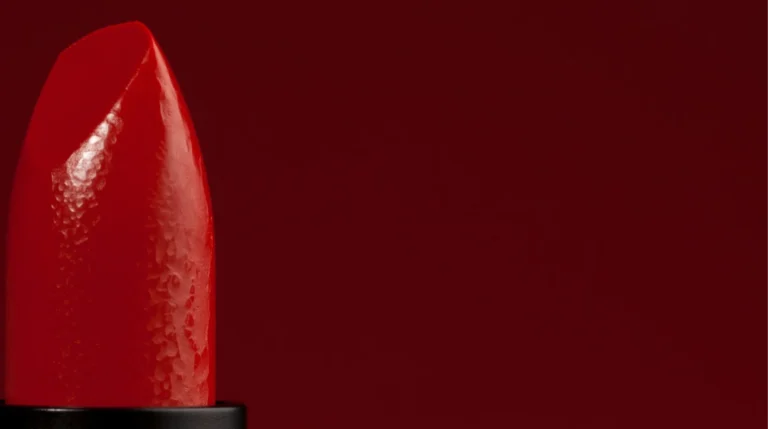
Macro photography is a powerful tool for highlighting intricate details and textures in lipstick photography. By capturing close-up shots of the product, you can showcase the fine details, finishes, and colors of the product in a way that captivates and engages the viewer. Here are some benefits of using macro photography:
- Highlighting texture and details. Macro photography allows you to capture the smallest details and textures, such as shimmer particles, matte finishes, or intricate patterns. This can help showcase the quality and craftsmanship of the product, making it more appealing and desirable to potential customers.
- Creating a unique perspective. Macro photography offers a fresh and unique perspective on lipstick, allowing you to explore its features and characteristics in a way that is not usually visible to the naked eye. By getting up close and personal with the product, you can create visually interesting and engaging compositions that stand out and leave a lasting impression.
- Enhancing product presentation. Macro photography can help enhance the overall presentation, adding a level of sophistication and elegance to the images. By focusing on the fine details and finishes of the product, you can create high-quality images that highlight its beauty and allure, making it more enticing to potential customers.
Here are some technical tips for achieving successful macro shots:
Use a macro lens: Invest in a dedicated macro lens or a lens with macro capabilities to achieve sharp and detailed close-up shots of the lipstick. A macro lens allows you to focus on subjects at a very close distance, capturing the finest details and textures with clarity and precision.
Use a tripod: To ensure sharp and steady shots, use a sturdy tripod to stabilize your camera and prevent camera shake. This is especially important when shooting in macro mode, as even the slightest movement can result in blurry images. Consider using a remote shutter release or the camera’s built-in timer to further minimize camera shake.
Adjust your aperture: When shooting in macro mode, use a narrow aperture (high f-stop number) to increase the depth of field and ensure that the entire item is in sharp focus. Keep in mind that using a narrow aperture will require longer exposure times, so be mindful of your lighting conditions and adjust your settings accordingly.
Pay attention to lighting: Good lighting is crucial for successful macro photography. Consider using natural light or diffused artificial light sources to illuminate it evenly and enhance its textures and details. Avoid harsh or direct sunlight, as this can create harsh shadows and overexposed areas in your images.
By using macro photography techniques and following these technical tips, you can take stunning close-up shots that emphasize the intricate details and textures of the product. This will help you create visually captivating and engaging images that showcase the beauty and quality of the lipstick.
Monochromatic color palette
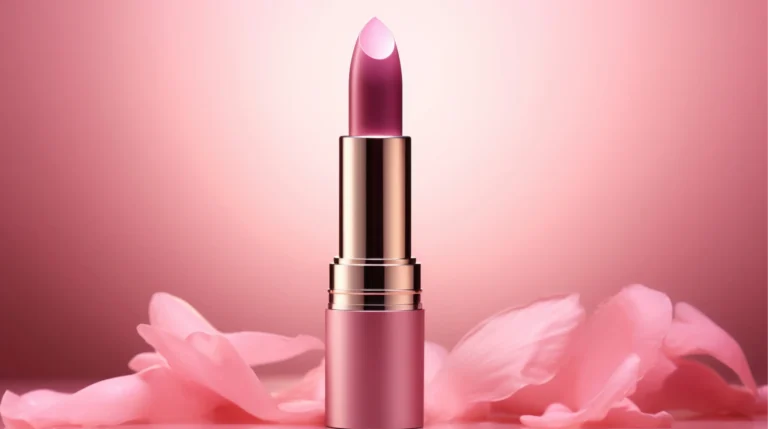
Using a monochromatic color palette can be a powerful way to create a visually striking image. By focusing on a single color, you can achieve a cohesive and harmonious composition.
This approach can also add an element of elegance and sophistication to the overall presentation of the product. Below are some of the benefits of using it.
- Emphasis on color. By using a single color palette, you can draw attention to the specific shade of the lipstick and showcase its color in a focused and impactful way. This can help highlight the vibrancy, richness, and nuances of the color, allowing viewers to fully appreciate its beauty and impact.
- Creating a cohesive look. A monochromatic color palette can help create a coherent and unified look, ensuring that all elements in the composition work harmoniously together. By simplifying the color scheme to a single hue, you can create a sense of balance, clarity, and elegance in your images.
- Focusing on texture and details. Using a monochromatic color palette can also help draw attention to the texture and details, such as its finish, sheen, or shimmer. By removing distractions from other colors, you can highlight the finer aspects of the product and showcase its unique qualities in a more emphasized way.
Here are some tips on creating a cohesive and visually appealing monochromatic composition:
Select a dominant color: Choose a dominant color for your monochromatic palette that best represents the lipstick shade you want to showcase. This will serve as the primary focus of your composition and set the tone for the rest of the image.
Use varying shades and tones: Incorporate different shades and tones of the dominant color to create depth and interest in your composition. Experiment with light and dark variations of the color to add dimension and contrast to your images.
Consider background and props: Select a background and props that complement the dominant color and enhance the overall aesthetic of the composition. Choose neutral or complementary colors that do not compete with the lipstick shade, but rather enhance and elevate it.
Pay attention to lighting: Lighting plays a crucial role in monochromatic photography, as it can affect the way colors appear and interact in the composition. Use soft, diffused lighting to enhance the richness and depth of the color, and create a flattering and cohesive look in your images.
Keep it simple: Avoid clutter and distractions in your composition by keeping the focus on the lipstick shade and its details. Simplify the elements in your image to ensure a clean and uncluttered presentation that allows the color to shine.
If you want to create visually stunning and cohesive photography, try using a monochromatic color palette and following these tips. This will help highlight the beauty and impact of the lipstick shade, while also adding a touch of elegance and sophistication to your images.
Dynamic motion shots
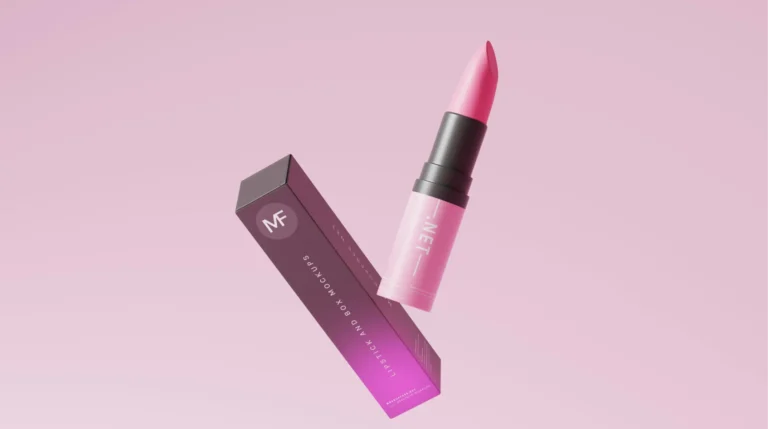
Incorporating motion into your product photography can add a dynamic and energetic element to your images. This creates visually engaging and exciting pictures that can capture the attention of viewers, highlighting the movement and vibrancy of the product. By capturing lipsticks in motion, you can bring a sense of life and movement to your images, creating a dynamic visual story that stands out and leaves a lasting impression.
Here are some ideas for creating dynamic and energetic images through motion shots.
- Lipstick swiping motion. Capture the moment when it is being swiped or applied onto the lips. This action shot can convey a sense of movement and activity, showcasing the texture and color payoff dynamically and engagingly. Experiment with different speeds and angles to capture the motion effectively and create visually interesting compositions.
- Spinning product. Showcasing a spinning lipstick can create a mesmerizing and captivating visual effect in your images. You can capture it spinning on its axis, creating a sense of motion and fluidity that adds a playful and dynamic element to the composition. Experiment with different spinning speeds and angles to create varied and dynamic shots.
- Dropping it. Capturing the moment when a lipstick is dropped or released can create a sense of action and movement in your images. This shot can convey a sense of anticipation and excitement, as the lipstick falls or descends gracefully and dynamically. Experiment with different heights and angles to create striking and visually impactful images.
- Lipstick splash. Experiment with creating a splash effect, either by dropping it into water or another liquid or by capturing the moment when it makes contact with a surface. This dynamic shot can create a sense of energy and excitement, as the item creates ripples or splashes that add a unique and dynamic element to the composition.
- Motion blur. Incorporate intentional motion blur in your images to convey a sense of movement and speed. This technique can add a dynamic and energetic quality to your photos, creating a sense of action and vitality that enhances the overall visual impact of the composition. Experiment with different shutter speeds and movements to achieve the desired effect.
Incorporating motion into your photography can create dynamic and energetic images. Experiment with different techniques and approaches to capture the beauty and vibrancy of lipsticks in motion. This will bring a sense of excitement and movement to your compositions, resulting in visually captivating and engaging photos that stand out and resonate with viewers. Unleash your creativity to create dynamic and visually striking images.
Wrapping up
Creativity is essential in lipstick product photography as it helps capture the beauty and essence of the product in unique ways. By experimenting with various techniques and concepts, photographers can elevate their work to create visually appealing images that resonate with viewers. The possibilities are limitless, so embrace creativity, let your imagination soar, and see where it takes you.
FAQ
How important is lighting in lipstick product photography?
Proper lighting is crucial as it helps to showcase the true color and texture of the lipstick and create attractive highlights and shadows.
Which background works best for lipstick product photography?
A simple, solid color background or a subtle pattern can help the product stand out without distracting it.
Should the lipstick be swatched or left untouched?
Swatching it on a model’s lips or hand can help viewers visualize the color better, but leaving it untouched can create a clean, minimalist look that focuses solely on the product.
Is it necessary to use props?
Props can add interest and context to the photo, but they should complement the lipstick rather than overpower it.
What angles work best for showcasing the lipstick?
Experiment with different angles, such as flat lays, close-ups, and angled shots. They can help highlight different features of the item, such as its packaging, texture, or color payoff.
